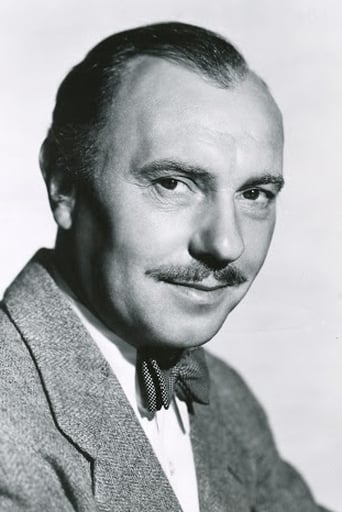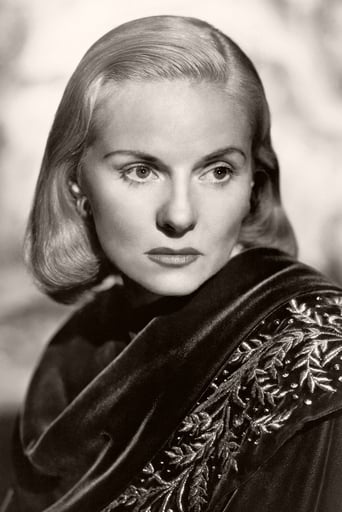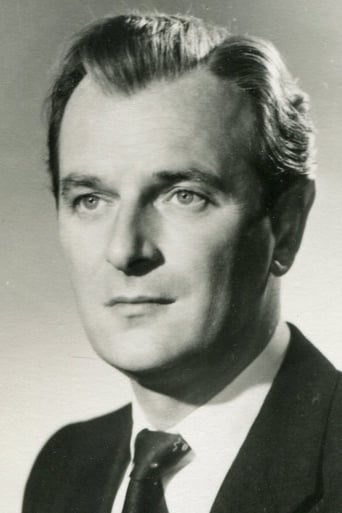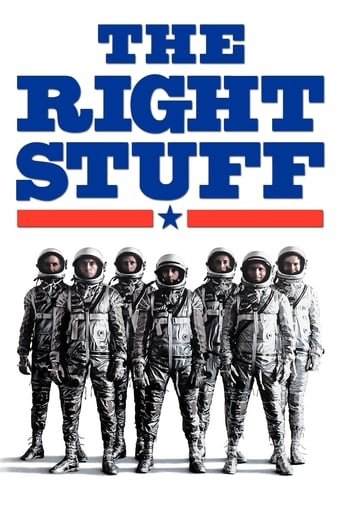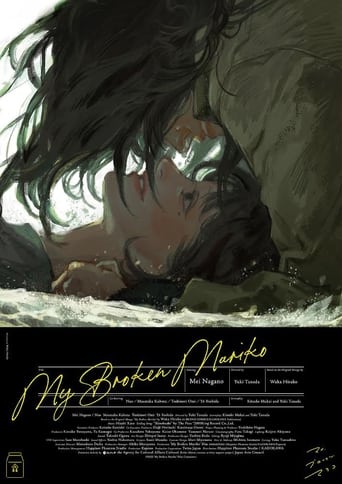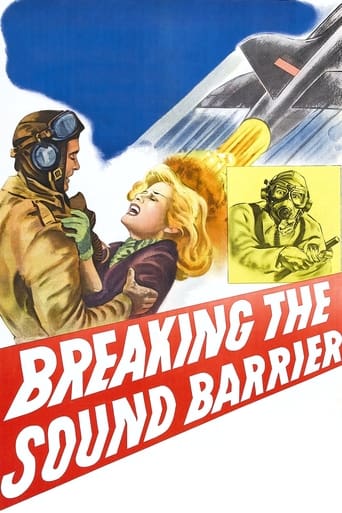
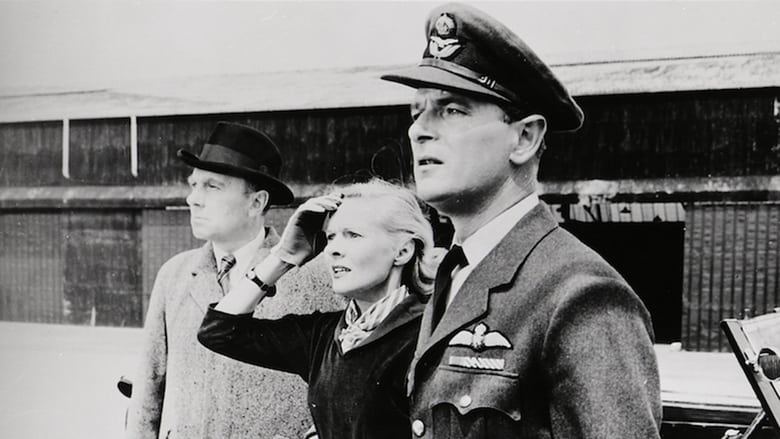
The Sound Barrier (1952)
Fictionalized story of British aerospace engineers solving the problem of supersonic flight.
Watch Trailer
Cast


Similar titles
Reviews
I first watched THE SOUND BARRIER on TV in 1975, and liked it immensely, finding it both informative and intelligent in its presentation- It keeps the viewer interested to the end, no doubt because David Lean's direction is very good, at times even inspired, and it is helped by extremely competent cinematography and a credible screenplay. Sir Ralph Richardson is superb as JR, a man obsessed with building ever better aircraft in competition with de Havilland and other companies, to the point of driving his son (well played by Denholm Eliott) and his son in law (Nigel Patrick) to their deaths. I also liked John Justin as the pilot who finally breaks the sound barrier. Ann Todd, who was married to David Lean at the time, somehow does not seem right for the part. I would have liked to see Vivien Leigh or Kay Walsh in that part, as both conveyed their emotions more readily and in greater depth. The technical aspects are succintly but clearly presented, and the discussion about the telescope and how what you see there is from 700,000 light years, and more, ago, certainly makes me realize my insignificance, every time I see THE SOUND BARRIER. David Lean had just come from making three masterpieces. BRIEF ENCOUNTER, GREAT EXPECTATIONS and OLIVER TWIST, and this is a transitional film, which already carries some signs of the epic that would emerge with the superlative THE BRIDGE ON THE RIVER KWAI, and be continued with LAWRENCE OF ARABIA, DR ZHIVAGO, RYAN'S DAUGHTER and, just before his death, PASSAGE TO INDIA. Recommended. 7/10
Written by Terrance Rattigan, this early 1950s British aviation movie is long on human drama, but somewhat deficient in the area of technical expertise. The British were NOT the first to exceed the sound barrier, and the manner in which it is accomplished in the film is rubbish. Although Terrance Rattigan was among the very best writers of his day, in this particular instance the producers might have done better to have hired Nevil Shute ("No Highway in the Sky"), who was not only a first-rate writer but was also a genuine expert on aeronautics. That being said, under the expert direction of David Lean there's plenty of good, British stiff-upper-lippishness, provided by the likes of Ralph Richardson, Ann Todd, Nigel Patrick, Denholm Elliot and John Justin. What makes the film even more interesting, however, at least to aviation buffs, is the presence of a variety of late 1940s British jet aircraft. Even more interesting is the fact that they are actually mentioned in the credits, as if they were members of the cast. In addition, it is worth mentioning that the aerial photography, although filmed in black-and-white, is quite excellent. Give this one a 7-out-of-10 for the aeronautical ironmongery and the flying scenes, and overlook the trite stuff on the ground.
You can't help comparing this to "The Right Stuff," particularly the sections that deal with Chuck Yeager's exploits. This movie stands up at least as well as the more expensive epic based on Tom Wolf's book, although "Breaking the Sound Barrier" is in black and white, virtually without special effects, and characterized not by arguments and competition, but by stiff upper-lipness and British taciturnity.Ralph Richardson plays the head of an aircraft manufacturing empire. His effete but game son feels compelled to become a flier because that's what the rigid Richardson seems to expect of him. End of son, played by a surprisingly undebauched looking Denholm Elliot.Richardson has a daughter too, Ann Todd. She marries a test pilot, Nigel Patrick, "not of your level," who is given a job flying new jets for Richardson's company. She wants them and their baby to have their own place and leave Richardson's house. "You must have noticed the distance between father and me," she confesses. "He's always resented me for not being a son." Patrick hasn't noticed. And at least one viewer (ie., me) had to think over earlier scenes to pick up on the hints. The Brits are like American Southerners, adept at reading others' emotional states from the smallest indications, and women are better at it than men.The director and writer -- David Lean and Terrence Rattigan -- pull a fast one on us two thirds of the way through. Owing nothing to Hitchcock's "Psycho" they kill off the protagonist and leave us gaping , the way Patrick leaves an untidy hole gaping in what appears to be an astonishingly tidy farm field, a bit of smoking wreckage scattered about.Patrick's friend and fellow pilot takes over the final mission to crack the sound barrier. The solution to the problem is too simple to be taken seriously but at any rate the pilot survives. An hour later, alone in a room, he begins giggling hysterically and turns to sobbing. Ya'd never see somethin' like that in an American movie like "The Right Stuff." Sobbin' is fer wimmin.But at least Richardson's humanity and horror and anguish are revealed when his daughter visits him more or less by accident. The final test is in progress and the radio transmissions are being piped into Richardson's office. "Forty-seven thousand now," says the pilot. "I'm taking her down for a final run." Richardson and Todd have had a brief argument and she is about to storm out when he begs her, "Please don't go! Don't leave me alone!" The human feeta clay after all.I want to emphasize that there are some novel techniques on view here. In 1950, when this was shot, jet propulsion was still something of a novelty. People didn't know what made jet engines go, and they had never heard of a sound barrier. So it comes as a surprise when we see a tiny object in the distance. It is a jet plane and is speeding towards us. But -- there is no SOUND. Its image looms larger on the screen until it is almost overhead and then -- WHOOSH. And we can figure out that there is no noise ahead of the aircraft because it is traveling almost as fast as the noise itself.There are two plane crashes. In any modern action flick they call for an enormous fireball of an explosion. But not here. One airplane, a fragile biplane, tumbles to earth and comes to rest tail up, seemingly in pretty good shape. The camera stays at a distance as people rush across the field towards the wreck. Then we see a wisp of oily smoke. Then billows of it, and then flame, and we realize that the pilot we thought was safe is now doomed. And Lean cuts from the other pilot to a distant office just before the crash. We not only don't see the crash. We don't even hear it.There's something else worth mentioning too. "The Right Stuff" at some moments gives us the excitement and the danger of flying but never the exhilarating joy of slipping around noisily in three dimensions. The first opening minutes of "Breaking the Sound Barrier" show us a Spitfire over Dover with a youthful pilot doing aerobatics, and the actor, the director, and the composer let us know exactly how he feels.Very good movie.
The opening of the film, when a World War II fighter pilot hit what used to be called "compressibility," was a suspenseful interlude for the audience, particularly since it wasn't explained at the time.The film was shot in monochrome, and was produced during a time that technology was accelerating, and this was one of the early films outside some of the science-fiction films of the era that was pro-technology. It is interesting that most of the major characters were obsessed with pushing the envelope.As has been mentioned elsewhere, the "solution" presented to maintaining control of a supersonic aircraft actually is inaccurate. When a reporter asked the person who first actually broke the sound barrier, Gen. Chuck Yaeger, about that "solution," he indicated that doing what was proposed would have ensured the death of the pilot.The film is well worth watching, if for no other reason than to get a taste of people taking baby steps in the new world of postwar technology.


